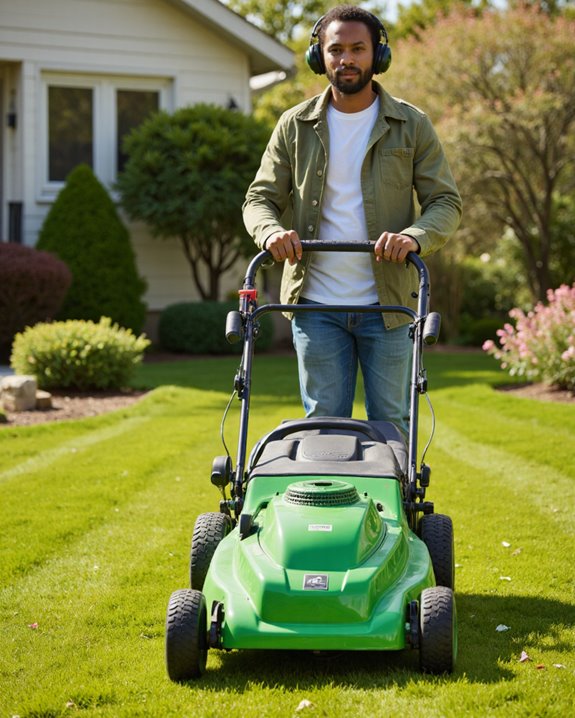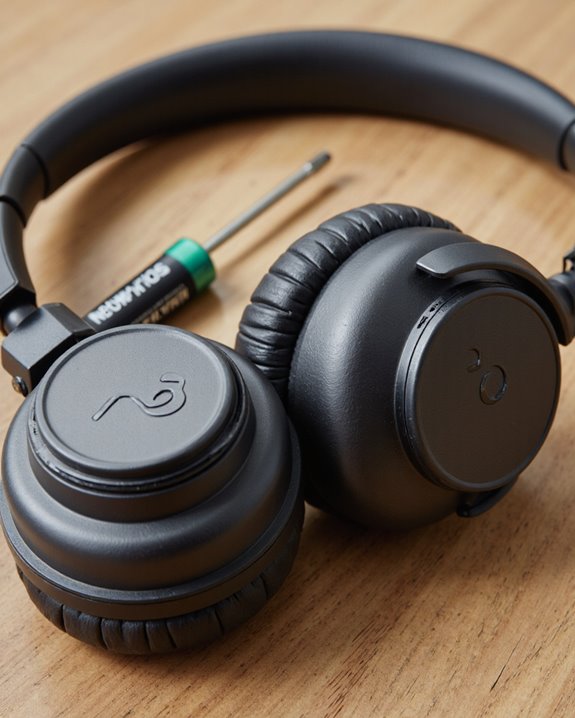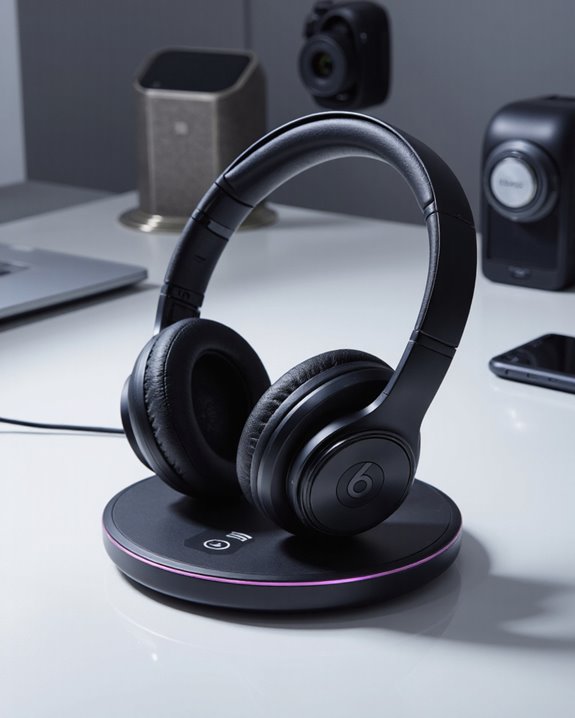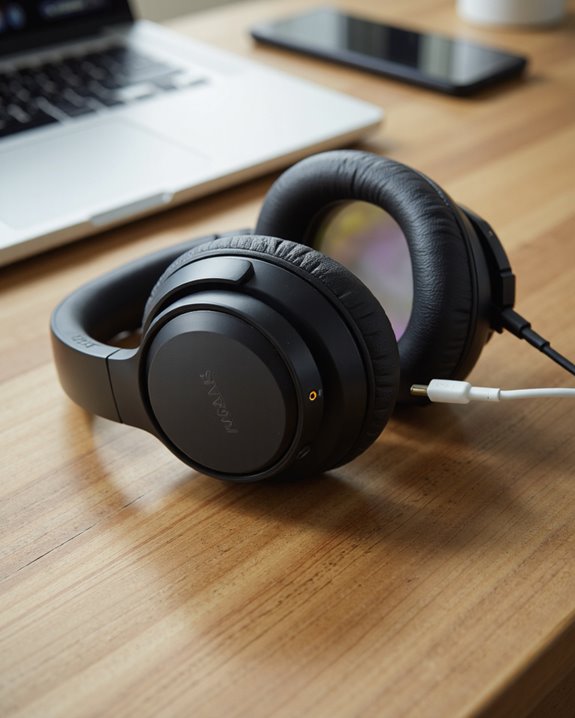As an Amazon Associate, we earn from qualifying purchases. Some links may be affiliate links at no extra cost to you. Although our opinions are based on curated research, we haven't used these products. Articles generated with AI.
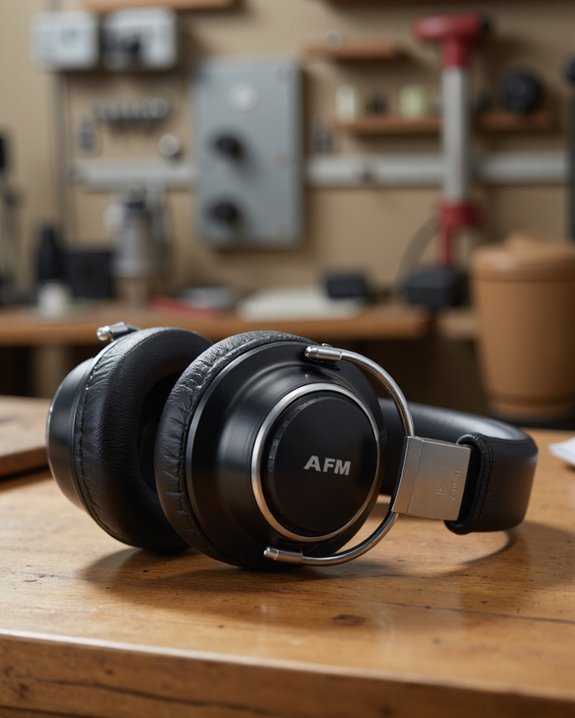
AM FM Hearing Protection Headphones: Safe Listening Solutions
AM/FM hearing protection headphones offer us safe listening solutions by combining robust noise reduction—typically with an NRR between 25dB and 30dB, compliant with ANSI and CE standards—with integrated radio reception, digital displays, and often Bluetooth connectivity for versatile input. We prioritize models featuring comfortable foam earcups, adjustable headbands, and reliable battery monitoring, ensuring both protection and convenience in industrial or outdoor settings. Careful maintenance and choosing reputable brands with top user ratings safeguard performance. For further comparisons and selection tips, continue below.
Key Takeaways
- AM/FM hearing protection headphones combine robust noise reduction (up to 30dB SNR) with built-in radio functionality for safe, enjoyable listening in loud environments.
- Digital LCD displays provide clear information on channel selection, battery status, and time, ensuring ease of use and safe operation.
- Soft foam earcups and adjustable headbands deliver comfort for extended wear while maintaining effective noise isolation.
- Bluetooth and 3.5mm AUX input options allow safe audio streaming from smartphones or other devices without compromising hearing protection.
- Regular maintenance, including inspection and cleaning, extends headphone durability and ensures continued safe listening performance.
Key Features of AM FM Hearing Protection Headphones
How do we determine which AM FM hearing protection headphones truly stand out? Let’s examine the essential features. First, effective hearing protection is a top priority, and leading models deliver a noise reduction rating (SNR) of 30dB, meeting ANSI S3.19 and CE EN352-1 standards. Integrated AM/FM radio capability allows users to store up to 20 stations per band, ensuring easy access to preferred channels. An LCD display provides clear battery, channel, and time information, simplifying operation in noisy environments. For enhanced comfort, soft foam ear cups and an adjustable headband accommodate prolonged wear. While some versions incorporate Bluetooth technology, most also include a 3.5mm AUX port for versatile audio input. These combined features make modern headphones both protective and user-friendly.
Types of Electronic Hearing Protection Available
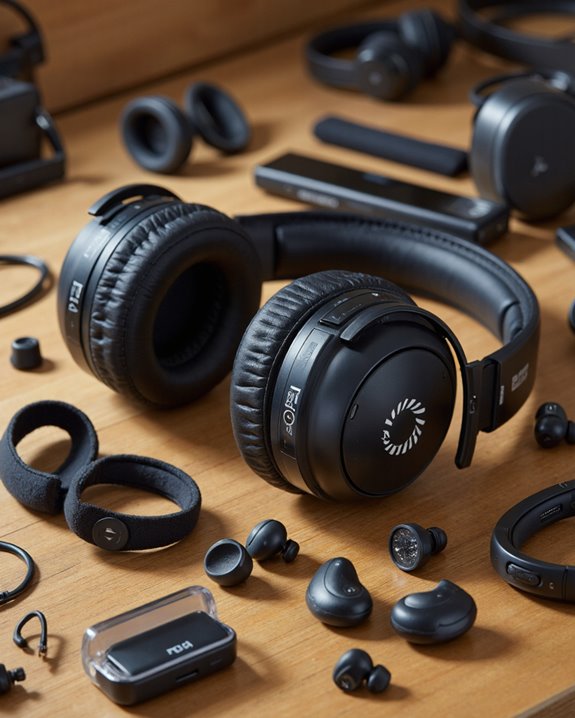
While standout AM FM models offer a strong balance of protection and usability, the broader category of electronic hearing protection presents a diverse range of specialized options tailored for different environments and needs. We’ll encounter AM/FM Hearing Protectors that integrate radio headphones with LCD displays, providing excellent sound quality and precise tuning. Bluetooth® technology is increasingly common, enabling wireless connection to smart devices or two-way radios without sacrificing ear protection. Integrated communication headsets support direct wireless communication in high-noise zones, while environmental listening headsets allow ambient sound passthrough in safe conditions, automatically blocking hazardous noise levels. Intrinsically safe headsets are engineered for explosive atmospheres, combining rigorous safety standards with communication capabilities. Protective entertainment solutions blend hearing protection with music or audiobook playback, offering both enjoyment and essential safety for users.
Essential Applications Across Industries
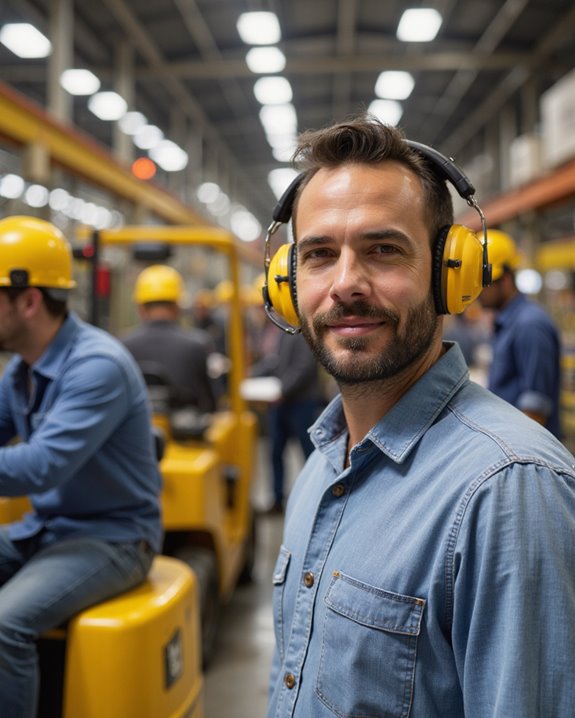
Across a wide range of industries, electronic hearing protection headphones have become indispensable tools for safeguarding workers against hazardous noise while enhancing productivity and comfort. In environments such as construction, heavy manufacturing, and law enforcement, hearing protection ear muffs with digital features deliver both safety and communication. High Noise Reduction Ratings (25dB–30dB) guarantee effective noise attenuation, making these safety ear devices suitable for prolonged exposure. Digital displays enhance usability, providing real-time battery, time, and channel data—a significant benefit during complex tasks. Integrated Bluetooth and radio performance allow simultaneous communication and entertainment, supporting focus and morale. Even in gardening work or landscaping, these headphones combine comfort—thanks to soft foam ear cups and adjustable headbands—with robust protection, illustrating their essential role across diverse applications.
Selecting the Best Headphones for Your Needs
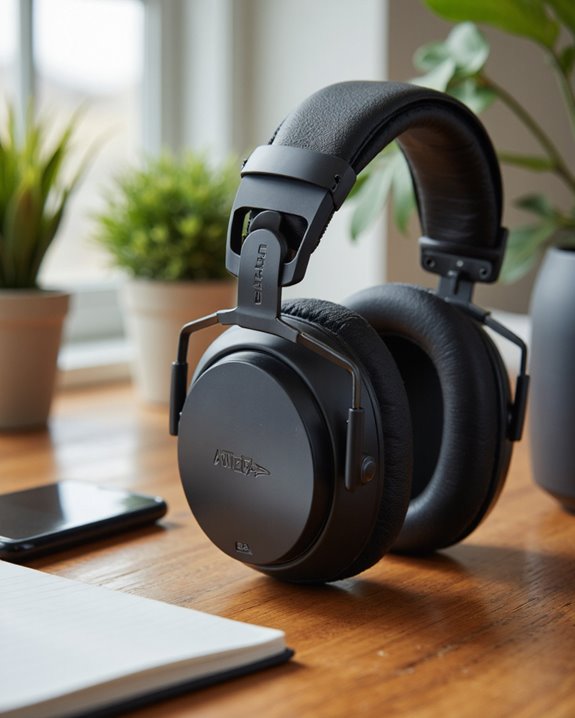
Selecting the best hearing protection headphones requires a careful assessment of both technical specifications and personal preferences. First, let’s examine the noise reduction rating (NRR). For effective hearing protection, models like the PROHEAR 027 offer a 25dB NRR, which greatly attenuates hazardous sounds. We should also prioritize headphones with a digital display—this feature allows us to monitor channel selection and battery status with ease. A comfortable design is essential for prolonged use; adjustable headbands and soft foam earcups reduce discomfort during extended wear. Additionally, consider functionality: the ability to store multiple AM/FM stations and connect external devices via a 3.5mm AUX port increases versatility. Reviewing user ratings—such as 4.5 out of 5 stars—can further guide us toward reliable, high-quality options.
Care, Maintenance, and Durability Considerations
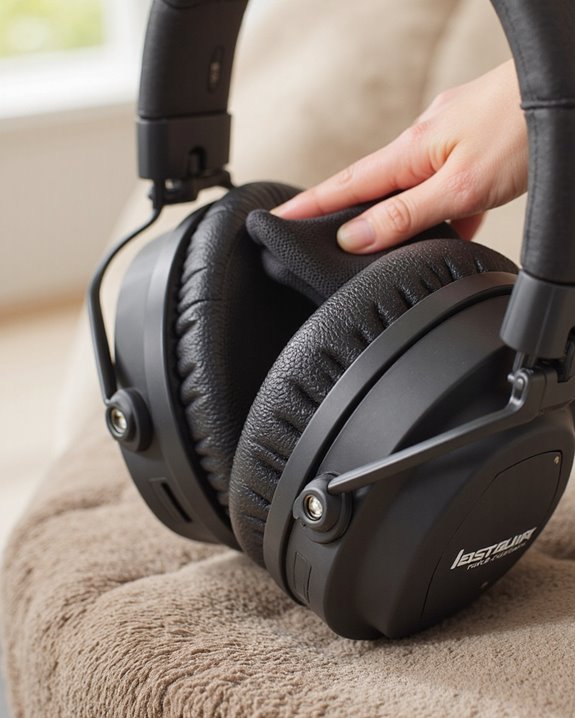
Once we’ve identified the right hearing protection headphones, it’s important to focus on their ongoing care and longevity.
Care and Maintenance
Regular inspection is essential—check for cracks or worn parts to maintain durability and protect your hearing. Foam and ear cushions generally last between 6 to 12 months; timely replacement guarantees continued comfort and effective noise reduction. For maintenance, store headphones in a clean, dry location, avoiding exposure to extreme temperatures, which could degrade electronic components and battery life. While most models tolerate light perspiration or rain, they’re not waterproof, so exercise caution in wet conditions.
Cleaning and Storage
Wipe headphones with warm, soapy water, steering clear of harsh chemicals that can compromise material integrity. Adhering to these care routines not only maintains performance but also prolongs the comfort and functionality of your device.
Comparing Popular Models and User Ratings
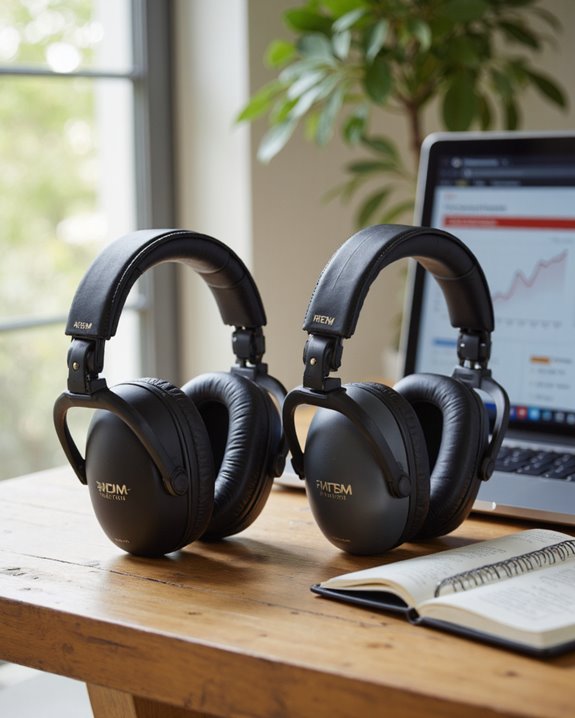
When we’re evaluating hearing protection headphones, it’s essential to look beyond basic specifications and dig into user ratings and model-specific features that impact real-world performance. Among AM/FM Radio Headphones, the 3M WorkTunes Hearing Protector stands out, boasting a 4.6 out of 5 rating from 2,462 reviews—testament to its robust noise reduction, comfort, and sound quality. The PROHEAR 027 follows with a 4.5-star rating from 96 users, offering both strong hearing protection and reliable Bluetooth connectivity. ZOHAN EM042s, rated at 4.3 from 82 reviews, impress with noise reduction and user comfort. The AM/FM Radio Headphones with Digital Display maintain a 4.5-star average from 614 ratings. For wireless preference, ISOtunes AIR DEFENDER earns positive feedback at $79.99, though from a smaller user base.
Frequently Asked Questions
Are Radio Headphones Safe?
When considering radio headphone safety, we should look at noise reduction technology, follow listening volume guidelines, and be mindful of prolonged use effects. Compared to regular headphones, they offer better sound quality and support hearing loss prevention in noisy environments.
What Kind of Headphone Can You Use to Protect Your Ears From the Noise?
When we’re looking to protect our ears from noise, let’s choose headphones with noise cancelling technology, a comfortable fit, and follow ear safety tips. Staying within sound exposure limits helps prevent hearing loss, especially during outdoor activities.
Does Electronic Hearing Protection Work?
We’ve found that electronic hearing protection really works, thanks to electronic noise cancellation and sound amplification technology. It helps us comply with safety regulations, improves workplace hearing safety, enhances communication, and offers great recreational usage advantages for everyone.
Can You Use Headphones as Hearing Protection?
When we use headphones for hearing protection, headphone noise cancellation helps, but it’s not enough for true hearing damage prevention. We should assess comfort levels, sound quality impact, and technology advancements, especially during outdoor usage scenarios for better safety.

